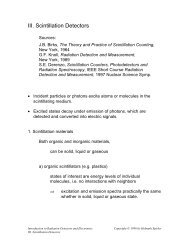VIII.2. A Semiconductor Device Primer
VIII.2. A Semiconductor Device Primer
VIII.2. A Semiconductor Device Primer
You also want an ePaper? Increase the reach of your titles
YUMPU automatically turns print PDFs into web optimized ePapers that Google loves.
Equilibrium is attained when the two currents are equal, i.e. the sum<br />
of the diffusion and drift currents is zero.<br />
The net hole current density is<br />
where Dp is the diffusion constant for holes and Ep is the electric field<br />
in the p-region.<br />
To solve this equation we make use of the following relationships:<br />
The hole concentration is<br />
so its derivative<br />
dp<br />
J p = −qeD<br />
p + qe<br />
pμ<br />
dx<br />
p = n e<br />
dx<br />
=<br />
i<br />
( E −E<br />
) / k T<br />
i<br />
dp F<br />
F<br />
p ⎛ dEi<br />
⎜<br />
kT ⎝ dx<br />
Since the force on a charge qe due to an electric field E is equal to<br />
the negative gradient of the potential energy,<br />
dEc<br />
qeE<br />
=<br />
−<br />
dx<br />
As only the gradient is of interest and Ec , Ev and Ei differ only by a<br />
constant offset, any of these three measures can be used. We’ll use<br />
the intrinsic Fermi level Ei since it applies throughout the sample.<br />
The remaining ingredient is the Einstein relationship, which relates<br />
the mobility to the diffusion constant<br />
μ p =<br />
Introduction to Radiation Detectors and Electronics Copyright © 1998 by Helmuth Spieler<br />
<strong>VIII.2.</strong>a. A <strong>Semiconductor</strong> <strong>Device</strong> <strong>Primer</strong>, Doping and Diodes<br />
B<br />
,<br />
dE<br />
−<br />
dx<br />
dE<br />
= −<br />
dx<br />
q<br />
e<br />
k<br />
D<br />
B<br />
v<br />
T<br />
p<br />
⎞<br />
⎟<br />
⎠<br />
p<br />
E<br />
p<br />
dEi<br />
= −<br />
dx





